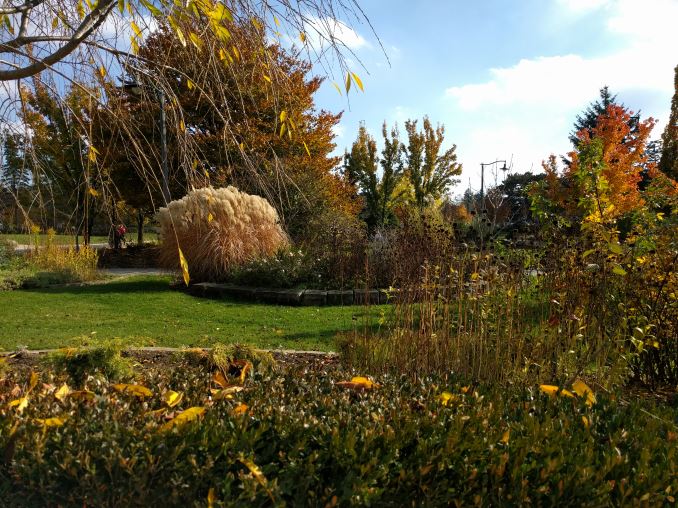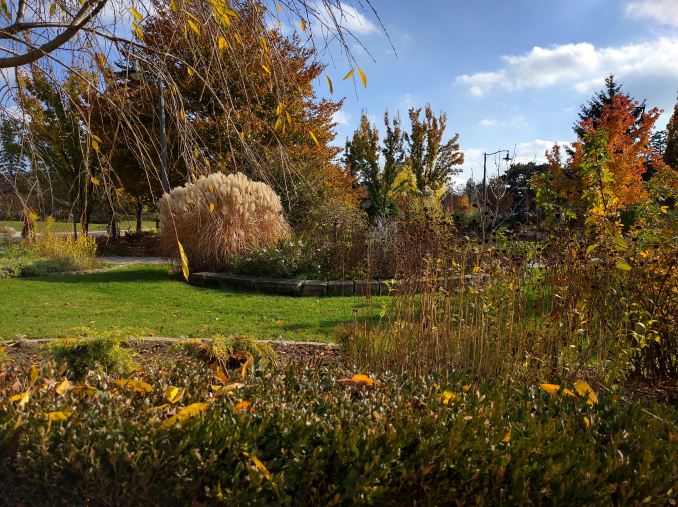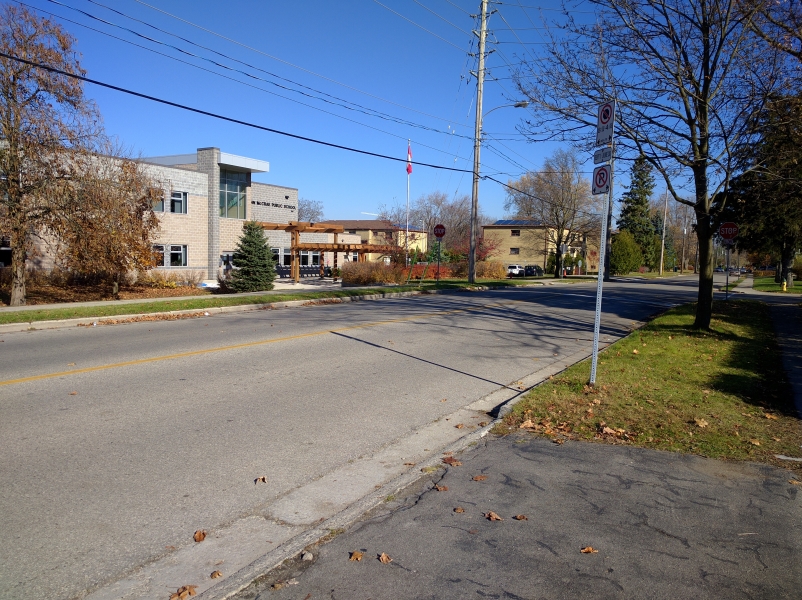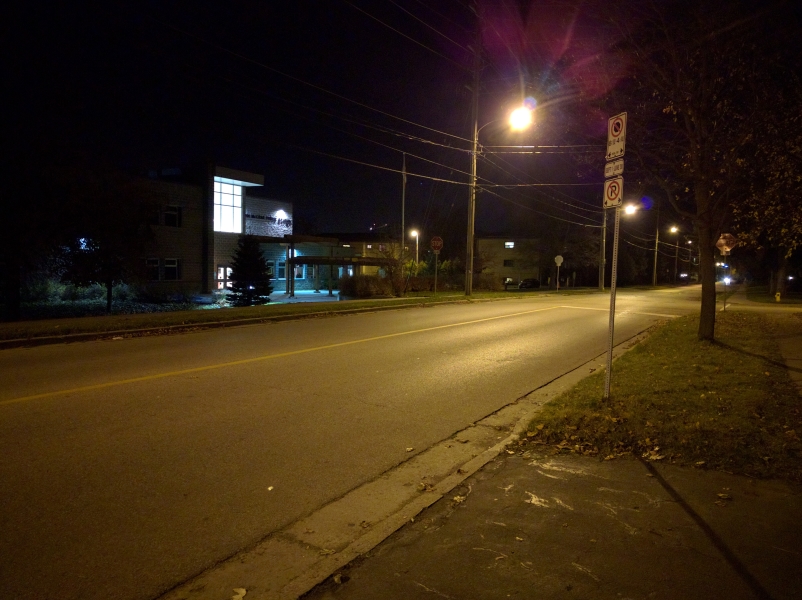The Google Nexus 5X Review
by Brandon Chester on November 9, 2015 8:00 AM EST- Posted in
- Smartphones
- LG
- Mobile
- Android 6.0
- Nexus 5X
The Effect of HDR+
HDR+ is a camera feature that originally launched on the Nexus 5. HDR+ is more like tone mapping from multiple images, which doesn't give you the dramatic contrast between dark and light that you sometimes get from HDR modes. What I've found interesting is that many statements from users say that using the HDR+ mode significantly improves the appearance and the exposure of their photos. I would actually agree with this based on my experience with the Nexus 6, but the problem in that case was that each HDR+ shot took multiple seconds to process which is simply unacceptable. This delay was even longer on the Nexus 5, which presents a problem with trying to just keep HDR+ on constantly to improve photo quality.
On the Nexus 5X, my observation has been that the camera often takes an incorrect exposure. I've displayed a sample comparison above, and while you have to take my word for it, the HDR+ shots are usually much more like what I actually saw when I took the photos. Most notably, the 5X would usually blow out the sky if it was even remotely bright out, while the HDR+ mode maintained a sky that was sometimes a bit too deep blue, but much better than the searing white of the overexposed shots. The normal images also seemed to tend toward a green white balance.
Of course, this presents a bit of a problem if we assume that HDR+ shots take a significant amount of time to process. It would mean that you're either stuck with waiting a long time between shots, or dealing with inaccurate colors and an overall incorrect exposure. Fortunately, you don't really need to make this choice, because software improvements bundled with Snapdragon 808's ISP improvements over Snapdragon 800 and 805 mean that HDR+ photos only take a second at most to be captured and processed. This means that you can just leave the HDR+ toggle on and take your photos.
To be honest, even though HDR+ mode improves the exposure, it's not really acceptable that Google is resorting to heavy processing and merging multiple exposures just to achieve a proper exposure. Relative to the single millisecond exposure time for a daytime photo, the second between shots to process the HDR+ photos is quite a long period of time. In addition, the lack of OIS means that even with Google's shifting and cropping of the exposures to account for blur you still run the risk of introducing blurriness into the photos due to the longer exposure time, especially when lighting is decent but not amazing and the exposures can take up to 100 milliseconds each.
For the purposes of these photo comparisons, HDR+ was generally left on, although non HDR+ versions are also included for reference. While this is somewhat unfair to the devices being compared, the true purpose of these sections is to give an idea of how well a camera performs with some relevant context in the form of comparison images from related and competing smartphones, rather than to just slot a phone somewhere in a list of the best smartphone cameras.
Still Image Quality
While we don't have a completely controlled test for examining a smartphone's image quality, a surprising amount of information can be gained just by comparing the photos taken by different smartphones in the same circumstances. I've taken test images on the Nexus 5X at my typical photo location during both the day and at night. Due to changing seasons I've had to retake my comparison images, and going forward there may be some phones or tablets that are no longer in the comparison due to the device samples being returned.
| Daytime Photography |
In my daytime test scene the Nexus 5X performs very well. In the HDR+ image much of the foliage actually shows an increase in detail compared to the Nexus 6, and the pavement doesn't have the unnatural texture that it does in the Nexus 6's image, which is a good sign of Google improving their processing and toning down the sharpening. The HDR+ mode definitely has a more accurate exposure than the standard mode, but both are not as close to what the scene actually looked like as the Nexus 6 and Galaxy S6 Edge. However, there are some other factors to be considered, and with them I think the Nexus 5X actually provides the best image quality of the devices in this comparison.
The first point is detail. Even with a lower sensor resolution, the sharpness and detail of the various trees and branches is much greater on the Nexus 5X than the Nexus 6. The second is distortion, and this is where the Galaxy S6 Edge runs into issues. Anything that is at all close to the left and right sides of the frame in the Galaxy S6's image is blurry and distorted, which includes the tree on the far left and anything to the right of the closest stop sign on the right. While I was concerned about Google spreading a lower resolution than the Nexus 6 across a wider field of view, they've really pulled it off and provided a great daytime camera.
| Nighttime Photography |
As I had hoped, the Nexus 5X really shines when taking photos in low light. Once again I have to use the HDR+ mode to achieve an acceptable result, and it actually amazes me how much worse the image looks without it. There's extremely heavy noise reduction causing detail to be smeared away across the entire frame, and there's a purple hue to the dark areas creeping in from the corners of the image. Meanwhile the HDR+ image is by far the best of all the photos I took. Detail is incredibly well preserved, with fairly fine grained luma noise and no issues with chroma noise. The fact that the scene now has a very close street lamp due to the leaves falling off the trees also shows how the Nexus 5X can handle the exposure without blowing out the light, while a phone like the Galaxy S6 Edge cannot.
The low light image quality of the Nexus 5X is the advantage of having such a large sensor with large sensitive pixels, and it really pays off. It's disappointing that you end up having to use the HDR+ mode even at night, because at that point you're pushing the exposure time pretty far and you could start to run into blurring issues caused by the hand shake. That being said, I am more than willing to wait a short moment for the HDR+ processing to get low light photos of this quality, but Google definitely needs to take a look at this next time around and try to achieve this level of quality without exposure merging and tone mapping.
While I don't normally do this, I like the 5X's camera enough that I decided to go around and take a bunch of pictures of different scenes to see how they looked. There are no comparisons to other devices, but sometimes it's important to just take a look at photos from a camera on their own to just get a general idea of the quality that can be expected. There are a number of images that I took both HDR+ and normal exposures for, and while it's fairly obvious which is which once you know what to look for, I've labelled each HDR+ image to make it clear.
Ultimately, the Nexus 5X (and Nexus 6P) mark the first time one can really say that the Nexus phones have cameras that are every bit as competitive with the best flagship devices, if not better. The caveat of course is that you do end up having to use the HDR+ mode a lot, which is definitely slower due to the longer exposures and the processing time after you take a shot. HDR+ photos also end up being between 1.5x and 2x the size of standard images, and so you're going to fill up a 16GB Nexus 5X much quicker if you take a lot of photos. However, if you can accept those concessions you'll be able to take great photos that people will find hard to believe were taken on a $379 smartphone.
Video Quality
The UHD recording mode encodes at 30fps using the H.264 Baseline profile. The average video bitrate is 42Mbps, and the audio is a single channel 96Kbps AAC track. Surprisingly, these are the same encoding settings as the UHD video on the Nexus 6. While this may give the impression that both devices have the same quality of UHD video, the most important improvement for me is that Google has seemingly fixed the issues with the frame rate that occurred when recording UHD video on the Nexus 6. One disadvantage is the Nexus 5X's lack of OIS. When comparing to the footage I shot for the Nexus 6 review it's clear that the 5X experiences more high frequency shaking. It's not clear if Google is able to apply EIS while recording UHD video, but based on what other OEMs have been able to do with the same ISP I would guess that there isn't any, and the shakiness of the video seems to support this. It's also important to note that even though Google doesn't mention it anywhere, the UHD mode can only record for five minutes at a time. Google should really have some sort of label or dialog box that lets the user know this when they switch from the 1080p setting,
I find it difficult to say if the 5X actually improves or regresses from the Nexus 6 as far as UHD recording is concerned. On one hand the elimination of the frame rate issues is a great improvement, but on the other hand the shaking is far more prevalent which is very distracting. Relative to the Nexus 5 it's definitely improved due to the sheer increase in resolution and bitrate.
In addition to the UHD recording mode, the Nexus 5X also does 1080p video. There's no 1080p60 option, so I honestly don't know why you'd select this mode unless you need to save space on your device. Not only is the quality significantly reduced compared to the UHD mode, but the high frequency shaking is still present. I don't know if Google is doing EIS in the 1080p mode either, but if you were to tell me that they are I would honestly be really surprised because the shaking is far worse than the videos I've taken on the iPhone 5s and the Galaxy S6.
Overall my recommendation for video recording on the Nexus 5X is to just always use the UHD mode unless you're running out of space, because the 1080p mode doesn't have any video stabilization advantage like you get when recording in 1080p on other Android phones. The overall shakiness is definitely a disappointing regression from the Nexus 6, but I like the fact that the UHD mode no longer drops frames which one could argue is actually more jarring visual artifact than high frequency shaking.




















197 Comments
View All Comments
zeeBomb - Monday, November 9, 2015 - link
Well well well! What do we have here? A 5x review without the 6P? I'll take it.Der2 - Monday, November 9, 2015 - link
Okay, read the whole review. Great work as always Brandon, and I just wanna put my thoughts out:That sustained performance though! Two minutes... Eek! Although that hits me right to my kokoro I think it isnt much of a big problem as someone like me who browses waaay more than gaming.
NAND performance. Oh man. One day AES hardware will be noticed. Or maybe a case of f2fs storage might help...hmm.
Its a blessing that Google is using great camera hardware for the first time. HDR+ All day every day kinda sucks as you basically have to rely on ISP and heavy processing, but as long as I get good photos out of it, I'm okay with that.
All in all, this is a great device for it's price point. Priced competitively and has good improvements over the original 5. It really comes down to how google can maintain such good outcomings of a phone for a lot cheaper than other OEMS...
And I will always respect them for doing so.
zeeBomb - Monday, November 9, 2015 - link
Wow, great stuff you mentioned there man (totally something I would say!) As google has some losses in this device, the GOOD does outweigh the BAD in this type of scenario, which I applaud google for. F2FS may be still young, but the innovation to multiply your read write speed is something I can wonder a lot of phones will benefit from.The 808 may be a bummer for some, but a wiser choice to implement without sacrifing so much performance, as it really comes down to Qualcomm to learn from their mistakes and hopefully not make a crucial mistake like this again.
BTW the camera...woot! Can walk around and snap pics like no tomorrow! (P.S: The 5X doesn't have EIS, but only the 6P does).
Billie Boyd - Friday, November 27, 2015 - link
Between 5x and N6. I recommend going for N6 instead. Its highly rated by the consumers based on satisfaction (see http://www.consumerrunner.com/top-10-best-headphon... for instance...)Kookas - Friday, December 18, 2015 - link
It's also huge, however. It's nice to keep devices that you have to carry about all day compact.coolhardware - Monday, November 9, 2015 - link
Enjoyed this one! Definitely more likely to look at picking up a 5X after reading the Anandtech review.Interesting to see where the Nexus 5X slots in with other Nexus devices, specifically when it comes to pixel density (PPI)
http://pixensity.com/search/?search=nexus
Kumar Anand - Tuesday, November 10, 2015 - link
I am running Wi-Fi throughput test on Nexus 5X using iperf and I am getting much higher numbers than anandtech. Here is information regarding my test bed -a) iperf version : 2.0.5
b) iperf command used:
iperf -s -w 512k -i1 -u
iperf -c <ip> -w 512k -i1 -t 300 -u -b 300M -P3
c) AP: Netgear R8000, VHT80, CH:157, Open Security.
d) Environment: OTA (over the air) in a clean environment (i.e. no interference from other clients)
e) 2 runs each for UDP DL/UL, each iperf run is for 5min (300s).
f ) 3 iperf parallel streams (iperf -P3 option)
RESULTS:
UDP Uplink (UL): 642 Mbps, 702 Mbps
UDP Downlink (DL)): 678 Mbps ,708 Mbps
anandtech - Could you please clarify regarding your tests? I am curious to understand why your numbers are not matching my peak numbers.
1) What is SW build loaded on your Nexus 5X?
2) What is the AP configuration and make and model?
3) What is the tool/command being used?
jay401 - Tuesday, November 10, 2015 - link
Does this phone have WiFi Calling?DLimmer - Thursday, November 12, 2015 - link
Yes and no. A quick summary of Google-Fi in this review would help answer this question.Yes: Google-Fi is Google's solution to phone plans/service. It replaces your current carrier at a pre-paid rate ($20 for unlimited U.S. text and voice, $10 per 1GB of data... only pay for the data you use). Google has sourced cellular service from 2 companies and many Wi-Fi hot spots, and has placed hardware in the 6, 6P and 5X to enable seamless usage and switching.
No: Wi-Fi calling is only available on the Google-Fi network.
As stated, only 3 phones currently possess the hardware to use Google-Fi.
Der2 - Monday, November 9, 2015 - link
In my opinion, this is Googles finest phone yet: where the fan has schoice to decide!